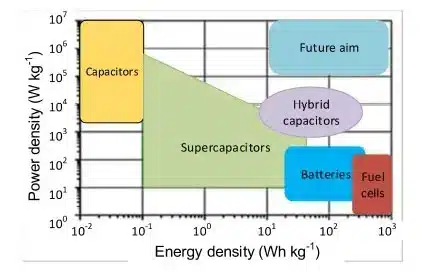This article based on Knowles Precision Devices blog elaborates of energy storage solutions – supercapacitors versus batteries.
Supercapacitors feature unique characteristics that set them apart from traditional batteries in energy storage applications. Unlike batteries, which store energy through chemical reactions, supercapacitors store energy electrostatically, enabling rapid charge/discharge cycles.
In certain applications, this gives them a significant advantage in terms of power density, lifespan, efficiency, operating temperature range and sustainability.
In this blog, we’ll explore how supercapacitors compare to conventional battery technologies and examine the key factors driving interest in supercapacitors for modern energy applications. For a high-level specifications overview, see Table 1.
High Power Density
Supercapacitors store energy electrostatically, so their power density ranges from 10 to 100 times higher than batteries. As a result, they can fully charge in a matter of seconds. Battery chemistry reactions occur at slower speeds, which impacts charge and discharge rates (typically measured in hours).
Long Life Expectancy
Due to mechanical and chemical degradation, rechargeable batteries wear out after a few thousand charge/discharge cycles maximum. Excluding those with polymer electrodes, supercapacitors have a much longer lifespan than batteries. The lifecycle of electric double layer capacitors (EDLCs) is nearly unlimited because electrostatic energy storage causes less wear and tear on components.
Wide Operating Temperature Range
Supercapacitors can function without significant degradation in environments ranging from −40°C to 70°C. Batteries, particularly lithium-ion batteries, can’t operate across that wide of a temperature range without overheating.
Eco-Friendly
Supercapacitors mostly consist of carbon and its compounds, so they biodegrade, and waste materials are easy to dispose of. Further, packaging is designed to minimize negative environmental impacts.
High Efficiency
In renewable power generation, energy efficiency is paramount. During charging cycles, supercapacitors only experience about 1 percent energy loss, compared to up to 30 percent for lead-acid batteries.
| Parameter | Lead-Acid Battery | Lithium-Ion Battery | Supercapacitor |
|---|---|---|---|
| Specific energy density (Wh/kg) | 10-100 | 150-200 | 1-10 |
| Specific power density (Wh/kg) | <1000 | <2000 | <10,000 |
| Cycle life | 1000 | 5000 | >50,000 |
| Charge and discharge efficiency | 70-85% | 99% | 85-98% |
| Fast charge duration | 1-5h | 0.5-3h | 0.3-30s |
| Fast discharge duration | 0.3-3h | 0.3-3h | 0.3-30s |
| Shelf life (years) | 5-15 | 10-20 | 20 |
| Operating temperature (°C) | -5 to 40 | -30 to 60 | -40 to 75 |
Energy Density vs. Power Density in Energy Storage
Supercapacitors are best in situations that benefit from short bursts of energy and rapid charge/discharge cycles. They excel in power density, absorbing energy in short bursts, but they have lower energy density compared to batteries (Figure 1). They can’t store as much energy for long-term use. Batteries are more suitable for applications where energy delivery occurs over longer durations. The balance between power density and energy density depends on the application requirements.

Common Supercapacitor Applications
While supercapacitors are used in many different application areas, they thrive under two key conditions.
- High-Power: With their built-in high-power characteristics, supercapacitors are critical in power electronics, where engineers are looking for short-time power peaks.
- Long Life Cycle: In low-power applications, like security installations, batteries present maintenance issues or insufficient performance over time. Supercapacitors can efficiently handle quick bursts of energy when needed and can endure many more charge/discharge cycles over time.
For a detailed review on leveraging supercapacitors for efficient wireless power in smart logistics, read our latest white paper.































